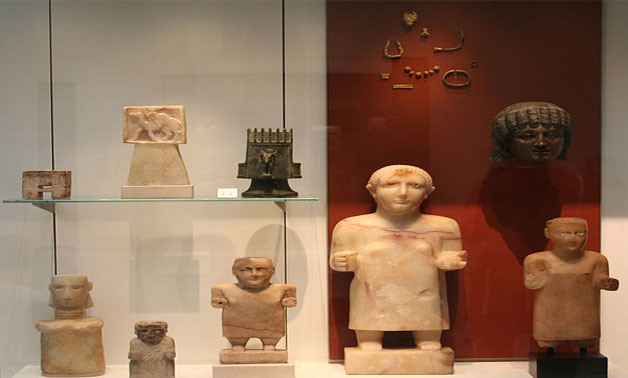
Ancient Yemen artifacts at the British Museun London - CC via wikimedia
CAIRO – 1 August 2017: It seems that Qatar’s plan for the region is not limited to spreading political chaos, fragmentation, and unrest in the Arab region, but also aims to erase the incredibly rich heritage of its countries. A Yemeni archeology expert, Mamoun Abdel Salam Abbad, said that Qatar funds terrorist Houthi militias to steal and smuggle Yemen artifacts to Doha, according to the alyemenialyoum news outlet.
The expert specialized in Yemeni archeology added that artifacts stolen by Houthi and Iranian militias are smuggled through the Red Sea in fishing boats to Ethiopia and other countries in the Horn of Africa, with support from Qatar. The Houthi militias smuggle the artifacts by military vehicles and ambulances. Abbad also said that there was clear evidence that Yemeni artifacts have been smuggled to the Qatar capital Doha.
Yemeni Deputy Interior Minister Ahmad al-Masawi said to Al-Arabiya TV on July 26 that the militias random digging and searching for artifacts destroyed the heritage sites. He added that the theft and destruction of heritage sites amounts to a war crime. However, there is a “suspicious” silence from the international community, according to al-Masawi.
Furthermore, Mohammed al-Arab, an Al-Arabiya TV channel correspondent covering the Arab coalition forces operation in Yemen, said on his Twitter account that "Houthi, Iranian and Qatari terrorist groups are responsible for losing many of Yemen’s artifacts."
According to Al-Arabiya, Yemeni sources revealed that the Qatar-supported leader of the Houthi militias, Abdul Malik al-Houthi, collected millions of dollars through smuggling Yemeni artifacts, in cooperation with Iranian and Lebanese figures from Hezbollah. The sources added that the outbreak of fighting in areas such as Marib, Al-Jawf and Taiz was not coincidental, but because these provinces contain the most important treasures of Yemeni heritage.
This is not the first time for Qatar to be accused of stealing and smuggling Yemeni artifacts. In January 2015, the Swiss public prosecutor stated that the authorities seized Yemeni artifacts that were shipped from Qatar. The seized artifacts date back to the third and fourth centuries. They were discovered in Geneva’s secretive free ports, which are warehouses that are often used to store expensive objects.
Below are photos of the Yemeni artifacts that were smuggled and shipped by Qatar to Switzerland

A circular table with decoration of ovals and head of ibex, origin southern Arabian Peninsula, Yemen

A statue of a praying man, origin Yemen

Anthropomorphic stele, origin Yemen

Anthropomorphic stele, origin Yemen

A quâtabanite registration stele, origin Yemen
Following this incident, France and the United Arab Emirates (UAE) launched a $100 million initiative to protect heritage sites threatened by conflict. According to UAE state news agency WAM, the initiative aims to create “safe havens” for endangered artifacts and to transport and restore monuments damaged by war. Both France and the UAE confirmed at that time that there is a need to protect heritage and to fight trade in works of art as part of the fight against terrorism and terrorist financing.
The conflict in Yemen, ongoing since February 2015, endangers a country with three world heritage sites recognized by the United Nations Educational, Scientific and cultural Organization (UNESCO). The Yemeni World Heritage sites include the historic town of Zabid, the Old City of Sana’a and the Old Walled City of Shibam. Poor security structures, lack of resources and funding, and ongoing civil war caused by the Qatar and Iran-backed Houthi rebels has severely damaged important historic sites and provided the opportunity to smuggle precious pieces of Yemen’s rich history out of Yemen.
In 2015, UNESCO launched an emergency plan to safeguard cultural heritage sites in Yemen, including the ancient city of Sana'a. UNESCO Director-General Irina Bokova said when the plan was announced, “It is evident that the destruction of their culture directly affects the identity, dignity and future of the Yemeni people, and moreover their ability to believe in the future.”
 Old City of Sana'a in Yemen - Photo credit UNESCO
Old City of Sana'a in Yemen - Photo credit UNESCO
 The Old Walled City of Shibam, Yemen, photo credit UNESCO - Editions Gelbarts
The Old Walled City of Shibam, Yemen, photo credit UNESCO - Editions Gelbarts

The Historic Town of Zabid, Yemen - Photo credit UNESCO - Editions Gelbart
On June 5, Egypt, Saudi Arabia, the UAE and Bahrain severed diplomatic ties with Qatar over supporting and funding terrorists, as well as the Houthi militias in Yemen. Furthermore, Qatar was expelled from the Arab alliance led by Saudi Arabia in Yemen.




Comments
Leave a Comment